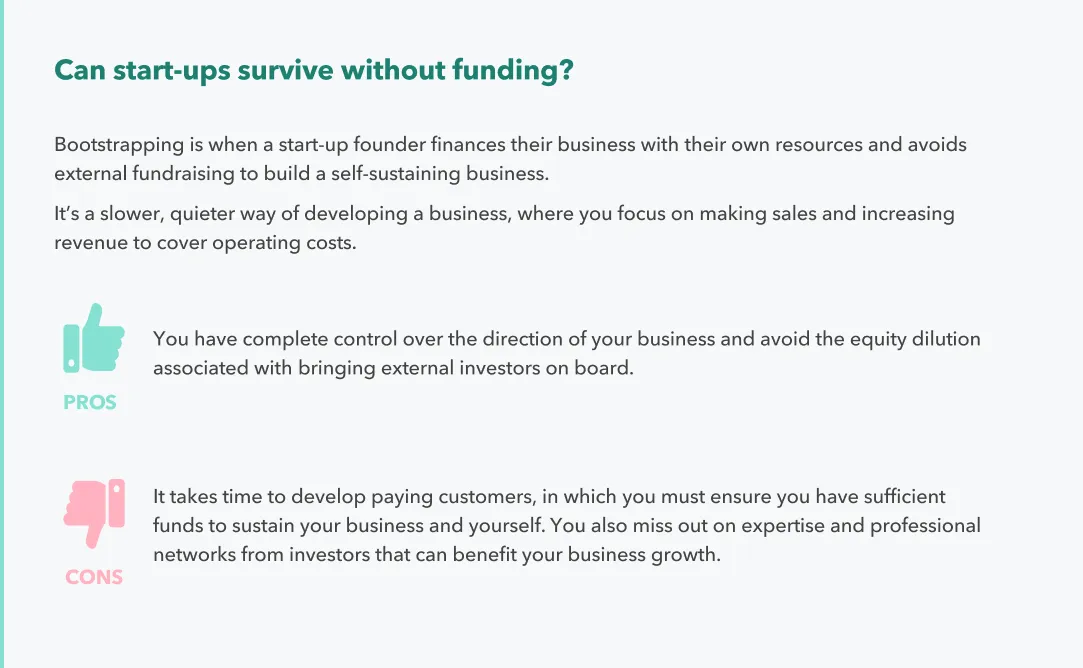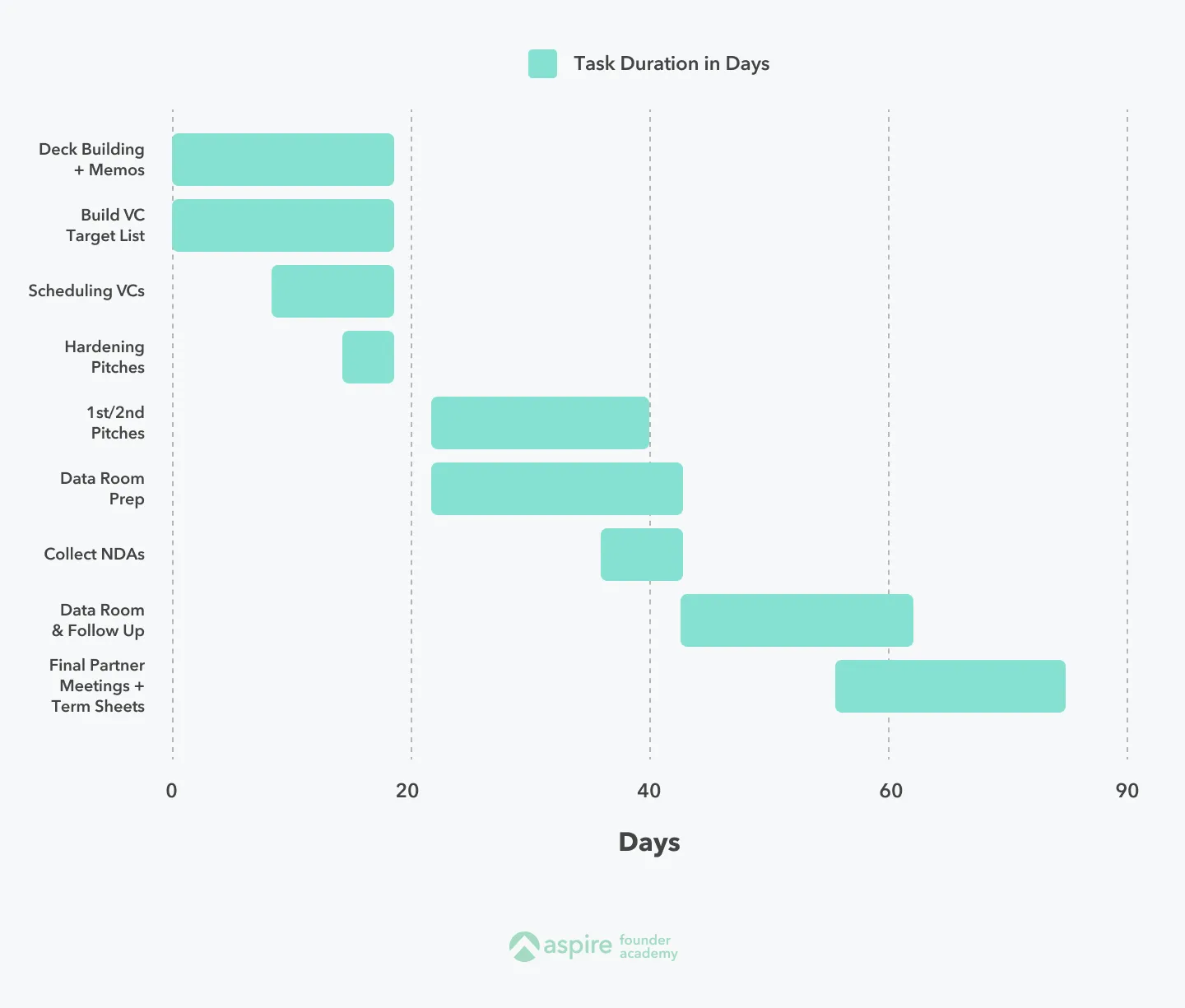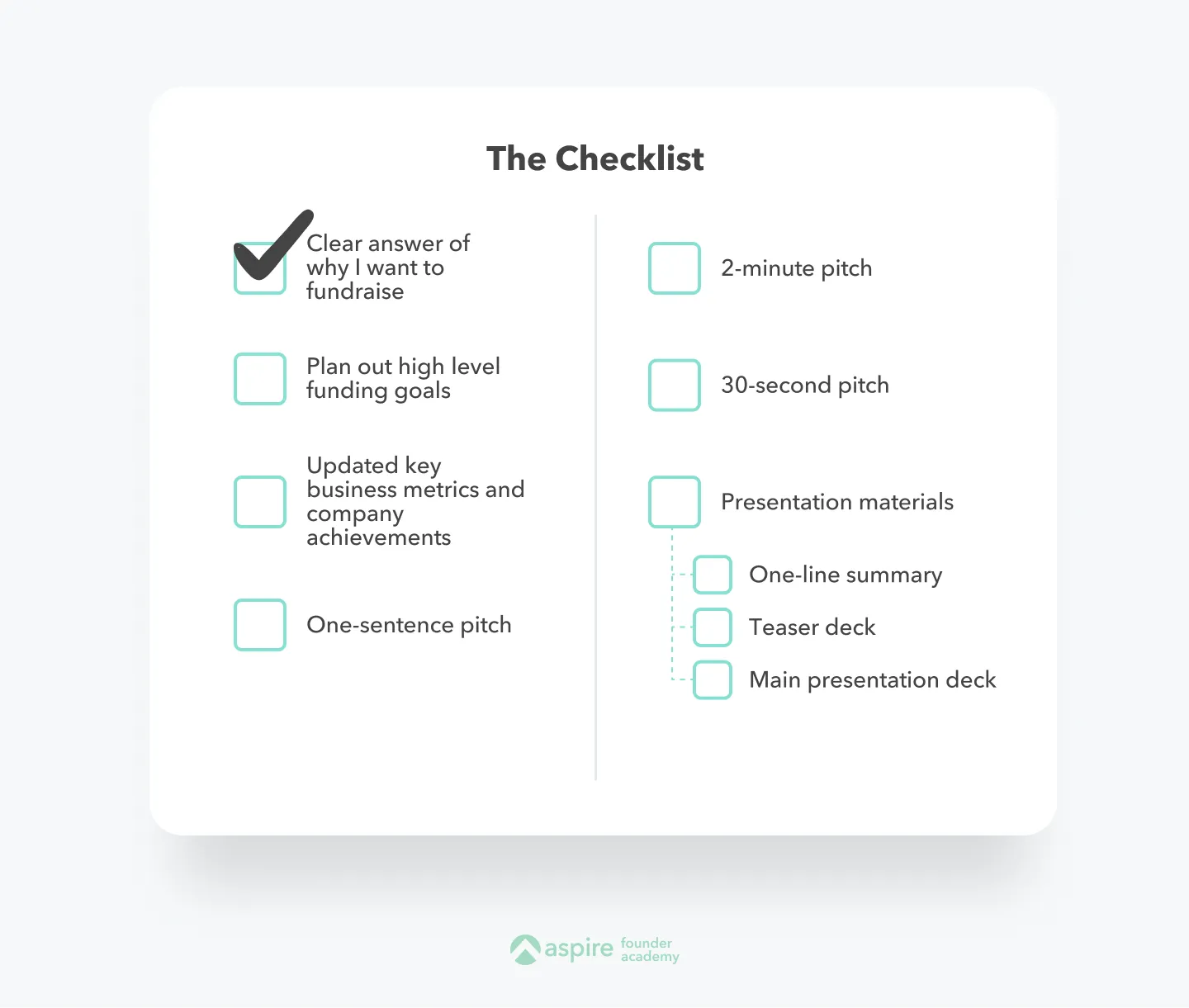Summary
No matter how big your company, there’s one essential skill you need to master as a start-up founder: How to raise funds.
We’re here to help you.
We’ve designed this comprehensive guide to walk you through the whole fundraising process for a growing start-up: From pre-seed funding to closing larger rounds later on in your start-up funding process.
You’ll learn how to prepare yourself and the company for fundraising, find potential investors and make the most out of these valuable meetings.
Let’s not waste time. Jump straight to the section that’s most useful to you:
Part 1: What is start-up funding?
Part 2: How does the start-up fundraising process work?
Part 3: How you can prepare yourself and your company for the fundraising process
Part 4: Finding potential investors
Part 5: What you can do to make the most out of your meetings with investors
Part 1: What is start-up funding?
Start-up funding is the process of obtaining money from external parties to start or grow an existing business.
Three ways raising funds can help grow your start-up
1. More upfront cash enables you to scale quickly
Speed is crucial for start-ups.
Closing a funding round means an upfront cash infusion to scale your business. Quickly get the resources to hire the right talent, invest in product development or expand into a new market.
2. Securing funding from prominent VCs lends credibility to your start-up
When an investor is willing to give you a large sum of money to build your business, it’s a vote of confidence that your start-up is on the right track. Being linked to prominent investors gives you credibility and usually leads to significant media coverage.
3. Investors come with other intangible resources beyond money
Investors come with their professional expertise and networks that can help you grow your business even more beyond the cash injection.
These investors can serve as business advisors, and introduce you to business development or talent acquisition opportunities. They can also make warm introductions to other investors.
How does start-up funding work?
Start-up funding rounds typically involve two parties.
- The individual looking to raise funds for their start-up:
This responsibility usually falls to the founder and CEO of the company or a founder in charge of fundraising.
Start-ups go through various funding rounds as the business matures: From pre-seed to Series A and beyond. Each round progression involves more significant sums of money and a bigger pool of investors. With each round, the founders of the company give up some equity and ownership of the company. - The potential investors looking to invest in promising start-ups:
Some investors invest in promising companies because they genuinely believe in what the start-up wants to accomplish. They also seek returns from their initial investment.
Investors gain partial ownership of a start-up from their initial investment. If the company becomes profitable, the investor can earn ongoing profits depending on the business’s success.

“Investors evaluate start-ups the way customers evaluate products, not the way bosses evaluate employees.” Paul Graham.

Comparing the different methods of funding a start-up
Let’s have a look at the advantages and disadvantages of some common start-up funding methods.
1. Friends and family
What: People you know with some money on the side.
Pros: Easy to access
Cons:
- You mix business and personal life, possible conflict of interest.
- Not as well-connected as angels and venture firms.
- These are usually unaccredited investors, which can complicate matters if your start-up makes it to the initial public offering (IPO).
How to find them: Personal introductions
2. Angel investors
What: Individually rich people
Pros:
- Angel investors are usually veteran entrepreneurs with their business expertise and professional networks.
- Shorter closing time and more straightforward due diligence compared with VCs.
Cons:
- Investment amounts are usually smaller than institutional investors.
- Fund-raising through angel investors doesn’t prepare you for a more process-driven fundraising process with institutional investors.
How to find them: Personal introductions, warm introductions, network with other successful founders.
3. Seed funding firms
What: Seed firms invest small amounts at early stages. They invest as a company and not as individuals like angel investors. Seed firms are also known as start-up incubators or accelerators.
Pros:
- Easier to reach than individual angel investors.
- A standardised investment process can avoid unreasonable terms.
- Provides ongoing advice and support on growing your business.
Cons:
- May distract from running your business as you’re encouraged to participate in social events.
- Not all mentors you meet may be relevant for your business.
How to find them: Search for curated lists and databases like Map of the Money and Aspire’s investor glossary.
4. Venture capital funds:
What: Venture capital funds pool investment money from private investors to invest in high-growth companies.
Pros:
- Larger investment amounts.
- Potential for improved professional network and credibility, especially for more well-known VCs.
Cons:
- Challenging to get and more complicated agreement terms.
- Founders have to give up some control to investors.
- May need to set up a formal reporting structure and company board of directors, impairing the decision-making process.
How to find them: Warm introductions, cold pitching, participating in start-up incubator programs.

When should you start approaching investors to raise funds?
Extra funds are always useful but generally, investors aren’t waiting to give you their money. That’s why timing is crucial. Look out for these four indicators to smoothen the fundraising process.
- You see strong business traction: It’s easier to pitch your business when you’re doing well. Potential investors like to see signs of solid business traction in the market and growth figures.
If you see increased demand for your product and services, and it’s tough to meet it based on your existing resources, you’re in an excellent position to raise additional funding. - You have at least 8-12 months of financial runway: Ensure your business has enough money in the bank so you can approach investors from a position of confidence.
- You have the time to commit to fundraising: Raising funds takes longer than you expect. During this time, you’ll need to juggle running your business with approaching investors, pitching and doing paperwork. This can be draining on top of your business responsibilities.
- You have a clear vision for the next phase of business growth: What do you plan to do with the funds? Fundraising is persuasion and investors are more inclined to write checks to confident founders with a real opportunity in the market and a clear plan forward.

Source: Lenny’s Newsletter
How much should you aim to raise?
With each funding round, you should aim to raise enough money to get to the next phase of your company’s growth. To figure out how long that’s going to take, think about what company milestones you need to hit before your next funding round. On average, it takes 12-18 months.
Aim for a growth milestone like customer acquisition, or a product development milestone like a product launch in the next six months.
You could also aim to raise enough money to reach profitability. Doing so increases the time between funding rounds to focus on growing your business.
Part 2: How does the fundraising process work?
A start-up goes through multiple funding rounds, typically securing more funds as they grow.
Types of funding rounds for start-ups:
Pre-seed
Investor type: Angel investors, start-up accelerators, crowdsourcing, friends and family
Product stage: Pre-product
Spend on: Prototyping and minimum value products (MVP).
Seed
Investor type: Angel investors, early-stage VCs, start-up accelerators
Product stage: Early signs of traction and product-market fit
Spend on:
- Exploring a business idea, finding product-market fit, and product development.
- Hiring the first team members beyond the founders.
TIP: Pick your seed funder carefully. They lay the foundation for future funding rounds by making the proper introductions or steering your business in the correct direction.
Series A
Investor type: VCs, super angels
Product stage: Accelerating initial growth and initial product-market fit
Spend on: Improving sales and marketing processes, catering to an ideal customer
Consider going for this round after you’ve found a few key customers in your market and once you’ve demonstrated you have an initial product-market fit.
Series B
Investor type: VCs & late-stage VCs
Product stage: Scaling
Spend on: Expensive hires, expanding into other markets and experimenting with different revenue streams
Series C and beyond
Investor type: VC, banks, private equity firms
Product stage: Large-scale operations
Spend on: Acquisitions, moving into new markets

Common fundraising questions for early-stage start-up founders
How many investors do I need to contact to close a funding round?
An average funding round involves about 50 meetings with investors. To increase your chance of success, prepare to reach out to 60 tailored investors and funds with relevant industry backgrounds.
How many times should I expect to get rejected?
Get ready to hear a lot of “no’s”. If you aren’t ready to hear at least 50 rejections, you should think carefully about whether you’re ready to fundraise.
Fortunately, there are ways to reduce this number. Work on getting to know investors early on in the process, prepare a strong pitch and ensure your business traction excites investors.
How does one fundraising round work into the next? Will I be doing this forever?
Don’t worry, you won’t be doing this forever. Each funding round should be sufficient to help you realise your next business milestone and provide enough financial runway for the next 12-18 months of operation. Every stage of fundraising denotes a new stage of company growth, more capital raised and a more mature organization.
How can I eventually make gains from fundraising?
As a startup founder, fundraising successfully gives you a money injection to quickly grow your business. You and your co-founders also have a stake in the company (also known as equity) which dilutes as you bring more investors on board during fundraising.
Besides your ongoing salaries from company profits, you and all other shareholders eventually make a profit when they sell part or all of the ownership in the company.
There are two common scenarios:
- Going public during an initial public offering (IPO).
- Getting acquired by another company during a merger and acquisition (M&A).
Consider how you want to ‘cash out’ on your company and build your company in that direction. For example, if you’re targeting an acquisition, you need to think about building a company that’s a valuable asset to an acquirer.
Part 3: Preparing for the fundraising process

Now you know why you need the money and where to get it, it’s time to get you ready for some action. First of all, you need to prepare well, because a successful fundraising cycle always starts with thorough preparation.
How long it takes for you to get funding, depends on how well-prepared you are. Below, you’ll find some of the items you should take care of before you start reaching out to potential investors.
Have a clear answer on why you want to raise funds
Why do you want to move to the next funding round? How will the investment help your business capitalise on its current growth?
Having a compelling reason behind your fundraising campaign will put you in a stronger position.
TIP: Look at the typical ways start-ups spend their funding round money according to the stages above to get inspired.
Plan out your high-level funding goals
To have a clear idea of what you want to achieve with each funding round, ask yourself these three questions:
1. How much do I want to raise and at what target valuation?
Assuming your next fundable milestone is in 12-18 months time, look at your average monthly burn rate, or how much you’re spending to stay in business. Include six months as a buffer for unexpected costs and marketing costs to both grow your business and close the funding round.
Also think about how much you need to spend to achieve your next business growth milestone. Include costs for hiring, research and other operational needs.
Use the development stage valuation approach as a quick and easy way to give yourself a target valuation. This model assesses your business’s valuation based on your progress.
2. How much time do I give myself to close the funding round?
The typical start-up fundraising process takes about three to six months. But depending on the round you’re raising, add extra time to sort out paperwork, legal agreements and other documents. Set a timeline based on your available financial runway, internal priorities and the time you have for fundraising.
3. How will I track and measure my progress?
Think like a project manager and commit to the process. Build a tracker to measure your progress. See example trackers from Notion and investor Lenny Rachitsky’s Google Sheets template.
Develop the personal characteristics investors look out for
When trying to raise more funds, it’s not just about your business and product, it’s also about you. During your pitch, potential investors look for specific features. Be aware of the energy you’re projecting during all communications with potential investors.
Certain qualities indicate a start-up’s future success for investors:
1. Clear thinking and concise communication
Can you communicate your business model to your employees, customers, partners, and investors? Are you capable of fielding challenging questions while being respectful?
Serial entrepreneur and investor Nick Grouf acknowledges achieving this conciseness is difficult. But achieving this clarity helps you identify potential challenges and avoid million-dollar mistakes later in your company’s life cycle.
2. Leadership skills and personal connection to the product you’re building
Investor Marc Andreessen wants to understand why the founder created the product.
“Usually the first question I ask is "What inspired you to create this product?"—I’m hoping that it’s based on a personal problem that that founder had and this product is the solution to that personal problem.”
(Source: How To Raise Money)
3. Intellectual integrity:
Nick Grouf also looks for academic integrity and self-awareness. He prizes people who can introspect, understand their strengths and weaknesses, and aren’t afraid to be vulnerable in professional situations.
Compile your key business metrics and wins
Yes, your vision, product and personality are crucial. But investors also care about numbers. They invest in a start-up’s potential, and the best way to gauge that is with metrics.
Find data points that will get your investors excited about your business.
- Growth rates
- Revenue numbers
- Customer testimonials (even better if they are market leaders in your customer segment. If you’re raising a pre-seed or seed round, show early feedback from your initial customers).
- Achievements: Did you launch an essential product or surpass a certain amount of traction? Make it clear in your materials.
You’ll want to continue showing business traction during the fundraising process as investors can ask you for updated numbers towards the end, and you want to avoid shaking their confidence. Here's how you can create a data room for investors.
Putting it all together: Crafting a strong investor pitch
What are the stakes of making an investment for a VC?
As we’ve seen, the chances of receiving a round of funding are pretty slim. There’s a good reason for this.Each partner at a fund only makes 1 to 3 early-stage investments per year.
Their career is tied to how well these investments perform. That’s why investors are typically skittish about any start-up that comes to them asking for funding. You need to show that you’re confident about using their money to bring your business to a new level.
Storytelling elements are key
Pitches delivered as stories can be up to 22 times more memorable than just facts.
When pitching, your audience doesn’t remember data and figures, especially when presented with cold data points multiple times a day. They do, however, recall a compelling story with critical characters, drama, and emotion. Use the materials you’ve prepared to weave storytelling elements into your pitch.
Three types of investor pitches to prepare
1. Your one-sentence pitch
Explains what your product does in one sentence to help the investor picture the product in their mind
A great example structure from The Founder Institute:
“My company, name of the company, is developing a defined offering to help a defined audience solve a problem with secret sauce.”
2. Your 30-second pitch
Start a conversation about your company in three sentences:
- 1st sentence: Explain what your company does in a simple, straightforward manner. Think of it as explaining to your parents or a sibling what you do in one sentence.
- 2nd sentence: Explain how ample your market opportunity is.
- 3rd sentence: Explain how much traction you have? Think about your revenue, sales, or user numbers. For example, “We launched this in May, and we’re seeing 50 percent month-on-month growth”.
3. Your 2-minute pitch
The 2-minute pitch is similar to the 30-second pitch but with a few additional components:
- What’s your competitive advantage? What can you do better than the competition? Condense all the reasons that make you stand out from the competition in two sentences.
- How do you make money? Explain in one sentence.
- Information on your team: Emphasize your team’s accomplishments and experience. For example, if you’re the founders of a high-growth company or if you’ve held senior positions in a notable company in your space, call these out.
Other things you want to mention here:
1. How many founders your team has.
2. How long you and your founders have known each other.
3. What’s your ask? How much money are you raising, and what form does that money take? Are you raising on a convertible note or a simple agreement for future equity (SAFE)? Do you know your minimum check size?
What presentation materials should you prepare for a pitch?
Spend at least a month building out your presentation deck and supporting materials. You will need time to tweak your start-up’s narrative and let your points materialise.
A short blurb about your business
Include the one-line summary of what your business does and highlight your crucial impact metrics in a clear, bold manner that shows your business is doing well.
Teaser deck (3-8 slides)
Send this to your potential investor ahead of a meeting. Be careful not to share everything with your VC before meeting your lead partner.
Longer presentation deck (12-15 slides)
Use this as your main deck for in-person or virtual meetings.
2-3 year business forecast post-fundraise
What happens when you do get the money? Show your business projections post-fundraise for your potential investor.
11 elements to include in your investor pitch and pitch deck
- What are you building? Describe your product or service and how it’s precisely what your target customers need.
- Why are you building it? What problem are you solving? Tip: Tie this to a personal reason for a unique problem you faced and explain how your solution helps solve that issue.
- Why are you the best team to build this solution? Describe your unfair advantage over the competition.
- What’s your current business traction? Show your growth numbers.
- How will your current strategy capture market share and business revenue in the future? Tip: Speak to the broader trends happening in the world that you see as an opportunity for your business strategy.
- Business model: How do you make money?
- Describe your marketing and sales strategy.
- Describe your founders and key team members.
- High-level financial details. Show charts that describe your sales figures, total customers, profit and expenses breakdowns.
- What are you asking for?
- What are you going to do with the money? How would your business change after an investment?
Test your pitch with an audience before reaching out to potential investors
Investor Lenny Rachitsky recommends you take time to test your pitch with live audiences. Prepare your materials to 70% completeness, then find people to practice your pitch.
Speak to fellow entrepreneurs, friendly investors or other people in your network to test your materials and pitch. It’ll build your confidence and provide helpful feedback on how to improve your pitch before going into real meetings. You may also get introductions to relevant funds.
Creating your pitch deck
Five tips to give your pitch deck the best chance of success
- Keep it simple: Use the golden rule of presentations: One idea, one slide. You want your slides to convey simple, high-level concepts that are easy to grasp and leave room for questions.
- Use large fonts and images










%201.webp)


.webp)